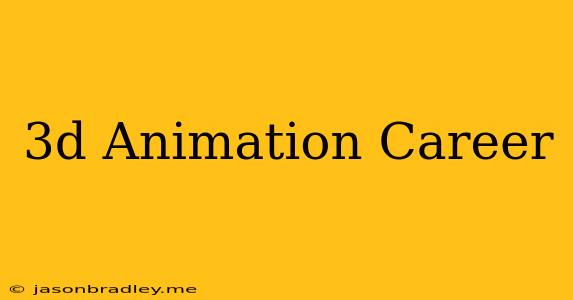3D Animation: A Career in Bringing Worlds to Life
The world of 3D animation is a dynamic and exciting field that offers a diverse range of career paths for creative and technically skilled individuals. From crafting breathtaking visuals for blockbuster films to designing engaging experiences for video games, 3D animators play a crucial role in shaping the way we experience entertainment, education, and even scientific research.
What Does a 3D Animator Do?
3D animators are responsible for bringing characters, objects, and environments to life through the use of specialized software. They utilize their artistic skills and technical knowledge to create believable movement, expressions, and interactions within digital worlds. Their work involves:
- Modeling: Creating 3D shapes and forms using software like Maya, Blender, or 3ds Max.
- Texturing: Applying surface details, colors, and materials to models to give them realism.
- Rigging: Building digital skeletons and controls to allow for movement and posing.
- Animation: Creating sequences of movement and expressions for characters and objects.
- Rendering: Generating high-quality images or video from 3D scenes.
Career Paths in 3D Animation:
The 3D animation field offers a range of career paths, each with its own unique set of challenges and rewards:
- Character Animator: Specializes in animating human or animal characters, focusing on realistic movement and expressive performance.
- Technical Animator: Focuses on creating complex and physically accurate animations, often for game characters or simulations.
- Environment Animator: Creates and animates realistic or stylized environments, including landscapes, buildings, and objects.
- VFX Artist: Creates visual effects for film, television, and video games, using techniques like compositing, particle effects, and simulation.
- 3D Modeling Artist: Specializes in creating high-quality 3D models for various applications, including games, animation, and product design.
- Animation Director: Leads the animation team, oversees the overall artistic direction, and ensures that the animation aligns with the project's vision.
Skills and Qualifications
To succeed in a 3D animation career, you need a blend of artistic and technical skills, including:
- Strong Artistic Skills: A strong foundation in drawing, anatomy, perspective, and composition.
- Technical Proficiency: Expertise in industry-standard 3D animation software.
- Problem-Solving Skills: The ability to troubleshoot technical issues and find creative solutions.
- Communication Skills: Effective collaboration with other animators, designers, and directors.
- Time Management and Organization: Ability to meet deadlines and manage complex projects.
Education and Training
While a formal degree is not always required, a solid educational background in 3D animation or a related field can significantly enhance your career prospects.
- Bachelor's Degree: A degree in Animation, Computer Graphics, or Digital Media can provide a comprehensive understanding of 3D animation principles and techniques.
- Certificate Programs: Short-term programs offer focused training in specific areas of 3D animation, such as character animation, modeling, or rigging.
- Online Courses: Various online learning platforms offer courses and tutorials covering different aspects of 3D animation.
- Bootcamps: Intensive programs provide hands-on training and portfolio development guidance.
Building a Portfolio
A strong portfolio is essential for showcasing your skills and securing 3D animation jobs. Your portfolio should include:
- Personal Projects: Showcase your creativity and technical skills by working on personal projects that demonstrate your abilities.
- Student Work: Include projects from your education, showcasing your understanding of animation principles.
- Professional Work: If you have any experience, include examples of your work from freelance projects or previous jobs.
The Future of 3D Animation
The 3D animation industry is constantly evolving, driven by technological advancements and changing trends. The future holds exciting opportunities for skilled animators:
- Emerging Technologies: Virtual Reality (VR) and Augmented Reality (AR) are opening new avenues for 3D animation in immersive experiences.
- AI and Machine Learning: AI-powered tools are assisting animators with tasks such as motion capture, facial animation, and rendering.
- Global Market: The demand for 3D animation is growing worldwide, offering opportunities for animators to work on diverse projects.
In Conclusion
A career in 3D animation requires dedication, creativity, and technical skill. However, with the right training, experience, and passion, you can unlock a world of exciting possibilities and bring your imaginative ideas to life.
